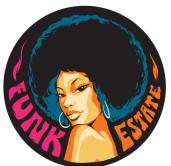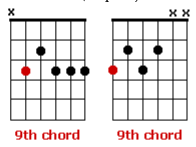The 9th Chord

The 9th chord (shown above) is a funk guitar staple used constantly by funk guitarists. Especially the chord on the left, with the root (notated by the red dot) on the fifth string. Be careful about playing the sixth string root 9th chord on the lower frets – it can sound very muddy.
The 9th chord is a 7th chord with one extra note, added for color. Try replacing 7th chords in songs you know with 9th chords. There are some situations where this substitution doesn’t work – use your ear to tell you what sounds right.
It is also EXTREMELY common for funk guitarists to only play the top three strings when playing the fifth string root 9th chord. Sometimes, they’ll even only play the top two strings.

Played on it’s own, this is a pretty “jazzy” sounding chord that might sound a little out of place in funk music. It is commonly used, however, as a “passing chord”. Note that the above 13th chord is essentially a 9th chord, with the note on the first string being two frets higher. Many funk guitarists will play the 13th chord, then quickly resolve it to the 9th chord, by removing their pinky from the first string, and playing the chord again.

There seems to be a preference in funk music to use chord shapes that have the root on the first string. Since the first and sixth string are both “E” strings, learning to use these chord shapes should be easy for guitarists who have already learned their note-names on the sixth string.
The major chord above gets used reasonably often, although many times, funk guitarists will only play the top two notes of the chord, which makes it identical to the 5th chord displayed above.
The minor chord above is also used extensively. Note that this minor chord shape is identical to the 9th chord with root on fifth string, when the bottom two strings are not played. So, many funk guitarists would play the above chord shape on the fifth fret for both an A minor chord and a D9 chord.
The above 5th chord is extremely popular. This two note chord is VERY versatile, and can be used for many things. Since a 5th chord can be used to play either a major or minor chord, the above shape, played at the fifth fret, could be an A major or an A minor chord. It could ALSO be the top two notes of a D9 chord. This chord shape is used to represent all of these chords – it’s a popular one – so get comfortable with it.
Notice the guitar player is playing NO muted strums in this part – simply repeating a four strum figure. Many of us, when playing a part like this, would feel a natural desire to include muted 16th note strums within the part. Avoid doing this.
The guitar plays a single-note line, but the minimal guitar part is very disciplined in that it does not stray from the riff.
This song sounds “busier”, and there are two guitarists, but listen to each of them, and you’ll note they’re repeating the exact same parts again and again, with no variation. Another example of the need for discipline in funk music. Pay attention to all instruments here – everyone plays their specific part, which adds to the whole.
This approach is a little different – perhaps a little less disciplined than the above style of playing funk. There is less space in this style of music, and guitar players in this style tend to play a lot more muted string strums, etc. The result is a groove that usually feels a little less laid-back, and more “frantic”. Have a listen to a few songs in this style:
Really active bass and drums give this song it’s somewhat frenzied, albeit very funky sound. The guitar player wisely stays largely out of the way, keeping muted strumming to a minimum (too many musicians being too busy at once can yield disastrous results).Stevie Ray Vaughan – Superstition
SRV’s take on the Stevie Wonder classic is a great example of this style of funk music. Vaughan fills up the space in the music with muted string strums to propel the music forward.Graham Central Station – The Jam
Bassist Larry Graham leads this one, and it’s another example of very robust, in-your-face funk, with little left to the imagination. Lots of busy strumming by the guitar player.
Designed to help you practice your 16th note funk strums. Good for “busier” funk music.
This YouTube video features Mel describing some basic funk rhythmic patterns. This style of playing would fall under “busy funk”.
This video lesson demonstrates Arlen Roth’s approach to playing funk guitar. Some nice licks and advice, although his style of funk guitar playing is too undisciplined for my tastes.
A fantastic video lesson from the legendary guitarist from The Meters. Nocentelli describes his process of creating a funk guitar part that mimics a drummer and horn players.

Now is the time to see some of the techniques we’ve learned in action! The following are just a few of the thousands of funk songs that feature 9th and 13th chords, muted strums, and more. Try listening to each mp3 clip, and concentrate on replicating the guitar part exactly. In almost every instance below, mimicking the notes is easy, but capturing the proper feel of the guitar part is much more difficult. Be patient and critical of your guitar playing for all examples.
This is a prime display of the funk guitarist’s use of a 13th chord to create an interesting part. Concentrate on deadening the strings with your fretting hand. Avoid adding muted strums to fill in the space within the guitar part. Try to make the riff groove without any extra strums.
The Temptations’ “Shakey Ground“

The notes are easy – getting the feel right is much tougher. The key is to “pop” the strings with your pick – strike them firmly, with careful attention to rhythm. The muting (not included in tab) should all be done via the fretting hand.
Jeff Beck’s “You Know What I Mean“

The classic opening cut on Blow by Blow, this features Beck at his funky best. Notice he avoids using any muted strumming, which you should try and reproduce. This is another example of a 13th chord moving to the 9th chord.
Kool and the Gang’s “Hollywood Swinging“

As is fairly typical of funk music, the bulk of this song is one chord. To create interest, the guitarist switches chord shapes from an E7 to an E9, which changes the sound slightly. Notice the subtlety in the rhythm pattern – the first three phrases start with an up-strum, but the last one begins with a down-strum.
James Brown’s “Papa’s Got a Brand New Bag“

This is a VERY common sort of funk guitar part – especially in earlier funk. The guitar is simply playing short quarter notes, staying out of the way of horns, and other instruments. When playing the flurry of 16th note strums at the end of the part, pay careful attention to playing the rhythms accurately. Note that the song is simply a 12-bar blues, played in a funk style.
Patrice Rushen’s “The Hump“

This is an almost cliche guitar part that nonetheless sounds cool, and can literally be played with one finger. The trick is the rhythmic aspect of the guitar part. Lots of muted strums here – pay careful attention to detail, and try to replicate the part perfectly.
pdf document here: Overview of Funk_s styles and guitar chords

